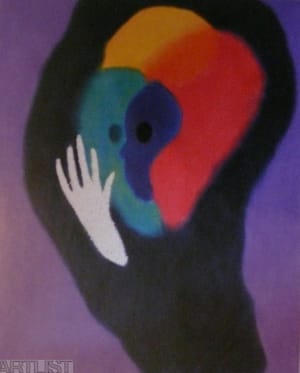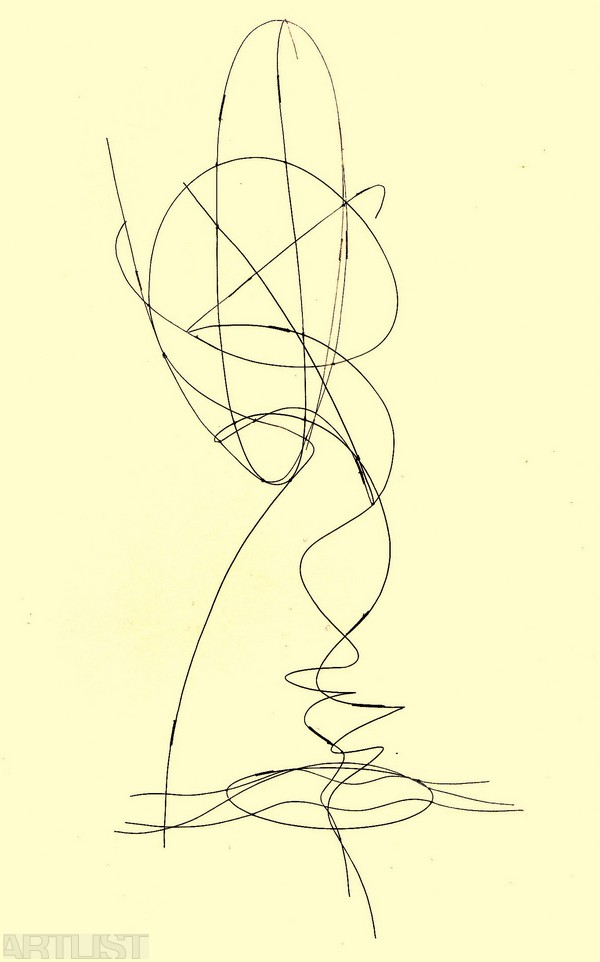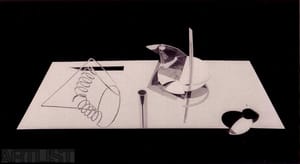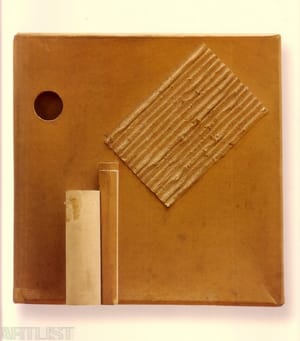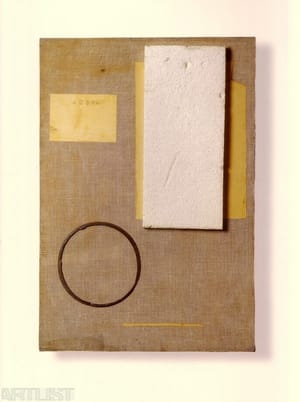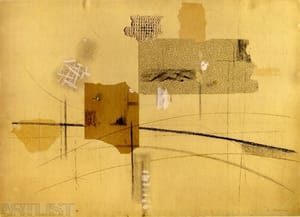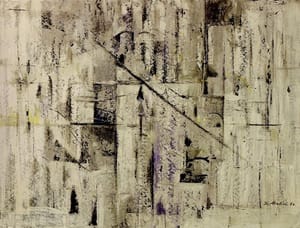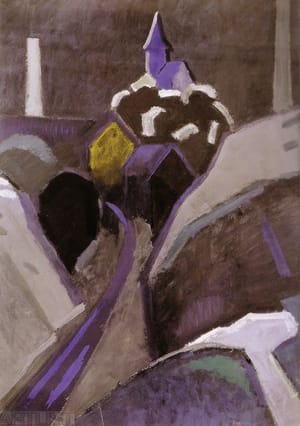- Jméno
- Karel
- Příjmení
- Malich
- Narozen/a
- 1924
- Místo narození
- Holice v Čechách
- Působiště
- Praha
- Úmrtí
- 2019
- i-datum
- ↳ Vyhledat v databázi VVP AVU
- Knihovna CSU
- ↳ Vyhledat v katalogu
O umělci
Despite a wide range of expressive and creative means, the work of painter, drawer, sculptor and graphic artist Karel Malich is internally very cohesive. An extreme sensitivity to the events of external and internal reality runs through them, as does a unique symbolism drawing on Malich's relationship to nature and on intense internal experiences. The first signs of abstraction in Malich’s work are evident in the paintings from the end of the 1950s: In White Landscape (1960) his work frees itself of direct reference to external reality that he transforms to a linearly structured abstract surface. A series of collages and assemblages at the start of the next decade foreshadowed later objects. In this series the artist glued rocks, sand, cork, Styrofoam, thread and rope into simple geometrical systems. In simplifying and freeing himself from a personal manuscript Malich at that time moved to radical monochrome reliefs (Landscape (White Relief), 1963; Black Relief, 1963), that turned completely away from the hitherto traditions of Czech art. Their surface consisting of corrugated cardboard was a unique reflection on the landscape viewed from above and as with the artist’s other monochromes they represented a “sensorial field”, not resigning themselves to content of an emotional and psychic nature.
Following the mid 1960s a number of reliefs and corridors in which Malich examined the possibilities of depicting spatial intersections, passages and areas for the movement of energy. The objects approached in their expression the constructive trends of the day (Black-and-white Sculpture, 1964-65; Yellow Corridor, 1968; Blue and Silver Corridor, 1967-68), but his work differed in that it was not created based on a rational concept, but, on the contrary, there is always a clear link to the artist’s internal experiences and often also to a landscape image, the artist's lifelong most important source of inspiration. At this time Malich began to work with sculptures hung freely in a space that led to his wire objects, forming the bulk of his work throughout the 1970s. Working with wire opened Malich’s way to unrestricted and immaterialized sculptures in the spirit of spontaneous spatial drawings. The wire objects, most of which are held together by coloured thread, hanging and lying on the ground, refer most frequently to the idea of a landscape’s energy and to natural events (Light-air (Cosmic Eggs), 1973-74; Energy, 1974; Landscape, 1974-75).
His exploration of the field of vision (The Border of Vision, 1976) culminated with the breakthrough object Another Beer? (1976). In this work Malich show his diversion from abstraction and all styles that were connected to it at that time and radically presents a new concept of art – and de-aestheticised and precise capturing of his own field of vision on the single moment of a seemingly banal reality. The gradual awareness of his own situated state in a time and space continued through intense internal experiences and states of sudden enlightenment that became the main theme of his work over the next decade. Another pivotal moment in Malich's work came in 1977 with the experience of discovering an inner light; just as unexpectedly and suddenly in later years follows the vision of his own soul, of eternity and of a crack in space. To depict his vision Malich turns increasingly to a more remote past (I Saw How I Was Conceived, 1980), and in the late 1980s writes the autobiographical prose work From That Time to That Time Now (1979-1980, in book for 1994), a remarkable text returning to the landscape around his native Holic. The nearby rocky hill that Malich referred to his whole life as if it occupied a central position in his personal mythology also figures in his most elaborate and complicated work, the ovoid sculpture Landscape with Eternity created over the course of the first half of the 1980s. After completing another large sculpture Human-Cosmic Intercourse (1984-1988) Malich continued mainly with works on paper. Most of his work from the 1980s consists of pastels and drawings derived from the artist’s inner visions and from the archetypal pictorial tradition (Harmonic Breathing with the Universe, 1981; Landscape with a Crack in Space, 1981).
- Autor/ka anotace
- Jakub Hauser
- Publikováno
- 2010
Profesní životopis
1963 member of the Křižovatka (Crossroad) group
1958 member of the Hollar Association of Czech Artlists and Graphic Artists
1950-1953 graphic art at the Academy of Fine Arts in Prague (prof. Vladimír Silovský)
1945-1950 Art education and aesthetics at the Pedagogical Faculty in Prague (prof. Cyril Bouda, Martin Salcman, Karel Lidický, František Kovárna)
- Členství ve skupinách zařazených do databáze
Výstavy
- Samostatné výstavy
-
2009
Karel Malich 85, Galerie Zdeněk Sklenář, Praha
2008
Tonutí v kráse, Galerie Zdeněk Sklenář, Praha
2007
Galerie Zdeněk Sklenář, Praha
2006
Památník Lidice, Lidice
2005
Galerie Zdeněk Sklenář, Praha
Trojlodí, Olomouc
2004
Galerie Zdeněk Sklenář, Praha
Městská knihovna, Praha
Galerie Benedikta Rejta, Louny
Dům U Jonáše, Pardubice
Rožmberský dům, Soběslav
2003
Galerie Zdeněk Sklenář, Praha
2001
Práce z roku 2000, Galerie MXM, Praha
2000
Východ slunce čistého světa, Galerie Šternberk, Šternberk
Dům umění, Opava
Prostor mého těla, Galerie MXM, Praha
1999
Výstavní síň Emila Filly, Ústí nad Labem
1998
Galerie MXM, Praha
Galerie U Bílého jednorožce, Klatovy
Výstavní síň Emila Filly, Ústí nad Labem
1997
Galerie 761, Ostrava
PORTFOLIO Kunst AG, Vídeň
Výstavní síň Sokolská 26, Ostrava
1996
ACP Galerie Peter Schuengel, Salzburg
Galerie MXM, Praha
1995
Kunsthalle Krems, Krems
Museum Fridericianum, Kassel
1994
Česká kresba 1, Karel Malich, Galerie umění, Karlovy Vary
Skicáky 1964 - 1980, Staroměstská radnice, Praha
1992
Galerie MXM, Praha
Tempery, kvaše a koláže z let 1958 - 1962, Galerie ´60/´70, Praha
Pastelle, Berlín
1991
Výstavní síň U Zeleného věnce, Olomouc
Galerie Lamaignere Saint-Germain, Paříž
1990
Art Galerie, Žďár nad Sázavou
Dům U Kamenného zvonu, Praha
1989
Divadlo hudby, Olomouc
Galerie výtvarného umění, Roudnice nad Labem
Zámek Pardubice, Pardubice
Dům pánů z Kunštátu, Brno
1988
Galerie umění, Karlovy Vary
Výstavní síň Bohumila Kubišty, Hradec Králové
Ústav makromolekulární chemie ČSAV, Praha
Státní galerie výtvarného umění v Chebu, Cheb
Galerie moderního umění v Roudnici nad Labem, Roudnice nad Labem
1987
Galerie Opatov, Praha
1986
Ústřední kulturní dům železničářů, Praha
1985
Dům kultury, Malá scéna, České Budějovice
1984
Malá galerie Vysoké školy veterinární, Brno
1972
Galerie Benedikta Rejta, Louny
1966
Galerie na Karlově náměstí, Praha
1964
Galerie Hollar, Praha
1963
Osvětový dům, Vysoké Mýto
- Skupinové výstavy nezařazené do databáze
-
2009
Boštík, Boudník, Grygar, Kmentová, Kolíbal, Kučerová, Malich, Nepraš, Sopko, Svobodová, Šimotová + Brabec: V SPEKTRU ROZMANITOSTI: 11+1, Dům U Zlatého prstenu, Praha
V spektru rozmanitosti / In the Spectrum of Diversity, Dům U Zlatého prstenu, Praha Linie Zdeněk Sýkora a Dráty Karel Malich / Lines and Wires (Dialog / A Dialogue), Museum Kampa, Praha
2008
Nechci v kleci! / No cage for me!, Muzeum umění Olomouc, Olomouc
Art Beijing 2008, National Agricultural Center, Beijing
Geometrie. Československý konstruktivismus a geometrická abstrakce, Galerie U Betlémské kaple, Praha
Česká plastika, Galerie Moderna, Praha
2007
Od sochy ...: České sochařství 2. poloviny 20. století ze sbírek Galerie Klatovy / Klenová, Galerie U Bílého jednorožce, Klatovy
Praguebiennale 3 - Glocal and Outsiders: Connecting Cultures in Central Europe, Karlínská hala, Praha
Členská výstava Umělecké besedy, Muzeum a galerie Orlických hor, Rychnov nad Kněžnou
Seskupení 5 + 5. Obrazy, koláže, kresby, grafiky, Trigon Gallery, Plzeň
Členská výstava Umělecké besedy, Novoměstská radnice, Praha
Současné české umění - Generační paralely, Galerie umění Zuraba Zereteli, Moskva
Členská výstava Umělecké besedy, Galerie výtvarného umění, Most
Od 60. let k současnosti, Trigon Gallery, Plzeň
2006
Šedesátá / The sixties, Ze sbírky Galerie Zlatá husa v Praze, Galerie umění, Karlovy Vary
České poválečné umění, Galerie U Betlémské kaple, Praha
Dostředivé okraje: Vizuální umění z Pardubického kraje, Dům U Jonáše, Pardubice
Od země přes kopec do nebe ...: O chůzi, poutnictví a posvátné krajině, Zámek Klenová, Klenová
Dostředivé okraje: Vizuální umění z Pardubického kraje, Zámek Litomyšl, 2. patro, Litomyšl
Klenoty českého umění, Galerie Zdeněk Sklenář, Litomyšl
V závěsu avantgardy? České výtvarné umění 1956 - 1978 ze sbírek Muzea umění Olomouc, Muzeum umění Olomouc - Muzeum moderního umění, Olomouc
Co se děje? Přírůstky Východočeské galerie z let 1993-2006, Východočeská galerie v Pardubicích, Pardubice
Svět české grafiky, Zámek Bruntál, Bruntál
2005
Privátní pohled (Sbírka Josefa Chloupka), Dům pánů z Kunštátu, 1. patro, Brno
Noční hlídka srdce: Výstava k 100. výročí narození Vladimíra Holana, Letohrádek Hvězda, Liboc
Prostor a čas, Galerie moderního umění v Roudnici nad Labem, Roudnice nad Labem
2004
Umění je abstrakce: Česká vizuální kultura 60. let, Staatliches Museum für angewandte Kunst, Mnichov
Ohlédnutí, 2. část, Oblastní galerie v Liberci, Liberec
Hudba ve výtvarném umění, Kolín nad Labem
Z národní klasiky, Galerie Zdeněk Sklenář, Litomyšl
Šedesátá / The sixties, Ze sbírky Galerie Zlatá husa v Praze, Dům umění města Brna, Brno
Kresba, kresba... Česká kresba 80. let 20. století ze sbírek členských galerií RG ČR, Výstavní síň Masné krámy, Plzeň
Blízká vzdálenost/ Közeli távolság/ Proximate Distance, Szent István Király Múzeum, Székesfehérvár
2003
Umění je abstrakce: Česká vizuální kultura 60. let, Jízdárna Pražského hradu, Praha
Svět jako struktura, Struktura jako obraz, Galerie U Bílého jednorožce, Klatovy
Svět jako struktura, Struktura jako obraz, Zámek Klenová, Klenová
Umění je abstrakce: Česká vizuální kultura 60. let, Uměleckoprůmyslové muzeum, Brno
Prazdroj české kultury. Umění inspirované pivem, Mánes, Praha
Umění je abstrakce: Česká vizuální kultura 60. let, Salon, Kabinet, Olomouc
Ejhle světlo / Look Light, Moravská galerie v Brně, Brno
Práce na papíře, Dům U Kamenného zvonu, Praha
2002
Objekt - objekt: Metamorfózy v čase / Object - object: Metamorphoses in time, Pražákův palác, Brno
Česká grafika. Půlstoletí proměn moderní grafické tvorby, Mánes, Praha
Divočina - příroda, duše, jazyk, Galerie Klatovy / Klenová, Janovice nad Úhlavou
Na papíře, Galerie MXM, Praha
Prostor pro tapiserii / Space for Tapestry, Uměleckoprůmyslové muzeum, Brno
2001
Barevná socha, Severočeská galerie výtvarného umění v Litoměřicích, Litoměřice
Bilance II, Obrazy a sochy, Galerie umění, Karlovy Vary
Možnosti proměny I, Galerie Františka Drtikola, Příbram
Objekt - objekt: Metamorfózy v čase / Object - object: Metamorphoses in time, Dům U černé Matky Boží, Praha
300 Years of Czech Decorative Art, Takasaki Museum of Art, Takasaki
Jiří Kolář sběratel / Jiří Kolář the Collector, Veletržní palác, Praha
Tendence 60. let IV. Obrazy, objekty, plastiky, kresby, grafiky, Trigon Gallery, Plzeň
2000
Prozařování, Oblastní galerie Vysočiny, Jihlava
Umělecká beseda 1999/2000, Mánes, Praha
Současná minulost: Česká postmoderní moderna 1960-2000, Alšova jihočeská galerie, hlavní sál, Hluboká nad Vltavou
Konec světa? The End of the World?, Palác Kinských, Praha
Z východních Čech, Galerie Zdeněk Sklenář, Litomyšl
Moderní česká kresba, Galerie Vltavín, Masarykovo nábřeží, Praha
Dva konce století 1900 2000, Dům U černé Matky Boží, Praha
Aktuální nekonečno, Městská knihovna, výstavní sály, Praha
90 let Domu umění města Brna, Dům umění města Brna, Brno
Bez předsudků: Experiment šedesátých let / Beyond Preconceptions: The Sixties Experiment, Veletržní palác, Praha
100 + 1 uměleckých děl z dvacátého století / 100 + 1 Art Works of the Twentieth Century, Dům U černé Matky Boží, Praha
1999
Přírůstky sbírek státních galerií z let 1990 - 1997, Jízdárna Pražského hradu, Praha
Kolorismus v českém výtvarném umění, Galerie výtvarného umění, Litoměřice
Prozařování, Galerie moderního umění v Roudnici nad Labem, Roudnice nad Labem
Prozařování, Galerie umění, Karlovy Vary
1998
Český informel ve Ztichlé klice / Czech informel in Ztichla klika (1958-1965), Galerie Ztichlá klika, Praha
...o přírodě..., České muzeum výtvarných umění, výstavní prostory, Praha
1997
Made in CZ, Knoll Galéria Budapest, Budapešť
Umění zastaveného času / Art when time stood still, Česká výtvarná scéna 1969-1985, Brno
Mezi tradicí a experimentem, Práce na papíře a s papírem v českém výtvarném umění 1939-1989, Trojlodí, Olomouc
Umění zastaveného času / Art when time stood still, Česká výtvarná scéna 1969-1985, Státní galerie výtvarného umění v Chebu, Cheb
Made in CZ, Dům umění města Brna, hala, Brno
Kořeny / The Roots, Mánes, Praha
České imaginativní umění, Galerie Rudolfinum, Praha
Česká koláž, Palác Kinských, Praha
Hollar 80 1917 - 1997. Grafická tvorba členů SČUG Hollar k 80. výročí založení, Staroměstská radnice, Rytířský sál, Praha
Umělecká beseda, Galerie Bayer & Bayer, Mostecká 16, Praha
Proměny krajiny v českém malířství 20. století, Veletržní palác, Praha
1996
Karel Malich, Zdeněk Sýkora, Galerie Teufel-Holze, Drážďany
Aktuelle tschechische zeichnung, Knoll Galerie, Vídeň
Eine Promenade der Romantiker, Stadtmuseum Göhre, Jena
Umění zastaveného času / Art when time stood still, Česká výtvarná scéna 1969-1985, Praha
Jitro kouzelníků? I. Od mediálních kreseb k cyberspace, Veletržní palác, 4. patro, Praha
1995
Nová citlivost, Dům umění, Opava
Nová citlivost, Pražákův palác, Brno
České výtvarné umění XX. století ze sbírek ČMVU, Dům U černé Matky Boží, Praha
Přírůstky sbírek 1989 - 1994, Oblastní galerie Vysočiny, Jihlava
Nová citlivost, Salon, Kabinet, Olomouc
Karel Malich, Zdeněk Sýkora, Galerie Heinz Teufel, Bad Münstereifel-Mahlberg
1994
Česká grafika šedesátých let, Palác Kinských, Praha
Zwischen Zeit und Raum I, Galerie Wendtorf + Swetec, Düsseldorf
Europa, Europa: Das Jahrhundert der Avantgarde in Mittel- und Osteuropa, Kunst- und Ausstellungshalle der Bundesrepublik Deutschland in Bonn, Bonn
Nová citlivost, Severočeská galerie výtvarného umění v Litoměřicích, Litoměřice Rudolf Steiner, Karel Malich, Jízdárna Pražského hradu, Praha
Ohniska znovuzrození, Městská knihovna, Praha
Nová citlivost, Dům U Jonáše, Pardubice
Umělecká beseda 1994, Mánes, Praha
Der Riss im Raum, Martin-Gropius-Bau, Berlín
Nová citlivost, Oblastní galerie Vysočiny, Jihlava
1993
Zweiter Ausgang / Second Exist, Ludwig Forum für internationale Kunst, Aachen
Identity Today, The contemporary Czech, Hungarian, Polish, Slovak Art, Centre des Conférences A. Borschette, Brusel
Poesie racionality. Konstruktivní tendence v českém výtvarném umění šedesátých let, Valdštejnská jízdárna, Praha
Záznam nejrozmanitějších faktorů… České malířství 2. poloviny 20. století ze sbírek státních galerií, Jízdárna Pražského hradu, Praha
1992
Svetlo v tmách, Považská galéria umenia, Žilina
20 let výtvarných výstav v Makru (1972 - 1992), Ústav makromolekulární chemie ČSAV, Praha
Situace 92, Mánes, Praha
České výtvarné umění 1900 1960, Středočeská galerie, výstavní síně, Praha
Písmo v obraze, Galerie Stará radnice, Brno
Přírůstky českého umění 20. století z let 1989-1992, Jízdárna Pražského hradu, Praha Situation Pragoise, Galerie Le Manoir, Ville de Martigny
Umělecká beseda 1992, Mánes, Praha
1991
Šedá cihla 78/1991, Dům umění, Opava
Český informel: Průkopníci abstrakce z let 1957 - 1964
Tradition und Avantgarde in Prag, Kunsthalle Dominikanerkirche, Osnabrück
České malířství a sochařství 2. poloviny 20. století ze sbírek AJG, Alšova jihočeská galerie v Hluboké nad Vltavou, Hluboká nad Vltavou
Tradition und Avantgarde in Prag, Rheinisches Landesmuseum, Bonn
Kunst, Europa, Tschechoslowakei, Kunstverein Lingen Kunsthalle, Lingen
Šedá cihla 78/1991, Galerie U Bílého jednorožce, Klatovy
Hořící keř, Emauzy, Praha
Kunst, Europa, Tschechoslowakei, Kunstverein Braunschweig, Braunschweig
1990
Les Pragois, les annees de silence, Galerie Lamaignere Saint-Germain, Paříž
Neue Blätter aus der ČSSR, Kupferstichkabinett, Drážďany
Les Pragois, les annees de silence, Galerie van Melle, Paříž
Výtvarné tendence, Středočeská galerie, Praha
Polyformie - Kunst als subversieves Element Tschechoslowakei 1939-1990, Martin-Gropius-Bau, Berlín
Současná česká kresba, Místodržitelský palác, Brno
Konstruktivní tendence šedesátých let, Severočeská galerie výtvarného umění v Litoměřicích, Litoměřice
Konstruktivní tendence šedesátých let, Středočeská galerie, Praha
1989
Tschechische Malerei heute, Galerie der Stadt Esslingen, Esslingen am Neckar
Recent Graphics from Prague, Corcoran Gallery - Dupont Center, Washington D.C.
1988
Expressiv, Central European Art since 1960, Hirshhorn Museum and Sculpture Garden, Washington D.C.
Contemporary Art in Czechoslovakia Selections from the Jan and Meda Mladek Collection, Herbert F. Johnson Museumm of Art, New York
Twenty Years of Czechoslovak Art: 1968-1988. A Tribute to Jacques Baruch, Jacques Baruch Gallery, Chicago
1987
Expressiv. Mitteleuropäische Kunst seit 1960, Museum moderner Kunst, Vídeň
1985
Přírůstky 1982-1984, Kabinet grafiky, Olomouc
Konstruktive Tendenzen II, Galerie Dialog e. V., Berlín
Wspołczesna sztuka czeska. Druga kolekcja Janiny Ojrzyńskiej, Galeria Bałucka, Lodž
1984
Wspołczesna sztuka czeska. Kolekcja Janiny Ojrzyńskiej, Muzeum Narodowe, Vratislav
Małe jest piękne / Small is beautifull, Galeria Zapiecek, Varšava
1983
Wspołczesna sztuka czeska. Kolekcja Janiny Ojrzyńskiej, Galeria Anny Wesołwskiej, Lodž
8 Künstler aus Prag in München, Künstlerwerkstätten, Mnichov
20 let Galerie hlavního města Prahy, Staroměstská radnice, Praha
Prostor, architektura, výtvarné umění, Výstaviště Černá Louka, Ostrava
1980
Kresby, Zámek Rychnov nad Kněžnou, Rychnov nad Kněžnou
Die Kunst Osteuropas im 20. Jahrhundert, Garmisch-Partenkirchen, Garmisch-Partenkirchen
1974
Tschechische Künstler, Galerie Wendtorf + Swetec, Düsseldorf
1972
Tschechische Künstler, Galerie Studio Orny, Mnichov
1971
Češka skulptura XX vijeka, Umjetnicka galerija BiH, Sarajevo
Premio Internazionale Biella, Museo Civico, Biella
Werken van Tsjechoslowaakse Grafici 1960 - 1970, Centraal Museum Utrecht, Utrecht
Konstruktive Kunst aus der CSSR, Galerie Sabine Vitus, Norimberk
1970
5 tsjechische grafici, Rijkmuseum twenthe, Enschede
5 tsjechische grafici, Groninger museum, Groningen
Konkrétistická grafika, Síň umění, Blansko
Demartini, Kratina, Kubíček, Malich, Sýkora, Alšova síň v Klubu skladatelů, Praha Tschechische Skulptur des 20. Jahrhunderts, von Myslbek bis zur Gegenwart, Schloss Charlottenburg, Berlín
Cien grabados y cien fotografias Checoslovaquia, Museo universitario de ciencias y arte, Mexico City
Artchemo, Galerie Václava Špály, Praha
Soudobá československá grafika, Dům umění, Hodonín
Graphics from Czechoslovakia, Willard Gallery, New York
1969
5 tsjechische grafici, Stedelijk Museum, Schiedam
4 Künstler aus Prag, Junge Galerie-Ernst Hühn Buchhandlung, Kassel
Klub konkretistů a hosté domácí i zahraniční, Galerie umění, Karlovy Vary
L´art tcheque actuel, Renault Champs - Élysées, Paříž
Salon de Mai, Sales d´Exposition Wilson, Paříž
Koláž v českém výtvarném umění, Malinův dům, Havlíčkův Brod
Obrazy - plastiky, 2. výstava přírůstků sbírky, Galerie Benedikta Rejta, Louny
Recent Graphics from Prague, 12th Floor Gallery
1968
Contemporary Czechoslovakian Art, Jacques Baruch Gallery, Chicago
5 Künstler aus Prag, Galerie Dr. H. Becher, Medebach
Klub konkrétistů a hosté, Oblastní galerie Vysočiny, Jihlava
Konstruktive tendenzen aus der Tschechoslowakei, Altstadtmuseum Fembohaus, Norimberk
Nová citlivost. Křižovatka a hosté, Dům umění města Brna, Brno
Klub konkrétistů a hosté, Dům kultury pracujících, Ústí nad Labem
Nová citlivost. Křižovatka a hosté, Galerie umění, Karlovy Vary
Alternative attuali III, Aquila
Nová citlivost. Křižovatka a hosté, Mánes, Praha
300 malířů, sochařů, grafiků 5 generací k 50. létům ČSSR, Praha
1967
Konstruktive tendenzen aus der Tschechoslowakei, Studiogalerie der Johann Wolfgang Goethe Universität, Frankfurt nad Mohanem
Tschechoslowakische Graphik, Kiel
15 grafiků, Galerie Václava Špály, Praha
Mostra d´arte contemporanea cecoslovacca, Turín
Konstruktivní tendence, Galerie Benedikta Rejta, Louny
1966
Obraz a písmo, Galerie Václava Špály, Praha
Konstruktivní tendence, Galerie výtvarného umění, Roudnice nad Labem
Nové cesty: Přehlídka současné avantgardy, Dům umění, Zlín (Gottwaldov)
Konstruktivní tendence, Oblastní galerie Vysočiny, Jihlava
Poezie písma, Národní muzeum, Praha
Aktuální tendence českého umění. Obrazy, sochy, grafika, Praha
Tschechoslowakische Plastik von 1900 bis zur Gegenwart, Museum Folkwang, Essen
Tschechische Graphik, Galerie Haus Metternich, Koblenz
1965
Zeitgenössische tschechoslowakische Graphik und Plastik, Kunsthaus, Hamburg
1964
Sdružení českých umělců grafiků Hollar 1963. Zakladatelé a současnost, Palác Kinských, Praha
Křižovatka, Galerie Václava Špály, Praha
1961
1. pražský festival mladé grafiky, Uměleckoprůmyslové museum, Praha
1959
4. přehlídka československého výtvarného umění, Praha
1958
Umění mladých výtvarníků Československa 1958, Jízdárna Pražského hradu, Praha
1953
Sdružení českých umělců grafiků Hollar: Členská výstava ilustrací a hosté Hollara, Galerie Hollar, Praha
175. členská výstava, Galerie Hollar, Praha
- Zastoupení ve sbírkách
- Národní galerie v Praze, Praha Galerie hlavního města Prahy, Praha Moravská galerie v Brně, Brno Muzeum umění Olomouc, Olomouc České muzeum výtvarných umění, Praha Východočeská galerie v Pardubicích, Pardubice Galerie moderního umění v Hradci Králové, Hradec Králové Galerie moderního umění v Roudnici nad Labem, Roudnice nad Labem Galerie umění, Karlovy Vary Alšova jihočeská galerie v Hluboké nad Vltavou, Hluboká nad Vltavou Státní galerie výtvarného umění v Chebu, Cheb Oblastní galerie v Liberci, Liberec Oblastní galerie Vysočiny, Jihlava Severočeská galerie výtvarného umění v Litoměřicích, Litoměřice Galerie Benedikta Rejta, Louny Galerie Klatovy / Klenová, Janovice nad Úhlavou Galerie výtvarného umění, Roudnice nad Labem Galerie výtvarného umění v Havlíčkově Brodě, Havlíčkův Brod Nadace Jana a Medy Mládkových, Praha Muzeum Sztuki, Lodž Slovenská národná galéria, Bratislava Centre Georges Pompidou, Paříž Albright- Knox Art Gallery, Buffalo McCrory Collection, New York, New York Museum d'Art et d'Histoire Geneve, Ženeva Museum Folkwang, Essen Stedelijk Museum, Amsterdam
Monografie, katalogy, publikace
- Vlastní texty zařazené do databáze
- Monografie, katalogy, publikace
Kujelová, D.: Karel Malich & utopické projekty, Brno 2021 Srp, K.: Karel Malich, Praha 2006 Ševčík, J. – Buchar, R. – Kulhánek, D.: Karel Malich. Wires / dráty, Praha 2005 Srp, K.: Karel Malich (kat. výstavy), Louny 2004 Dostál, M.: Karel Malich (kat. výstavy), Pardubice 2004 Kroutvor, J.: Dráty Karla Malicha, in: týž: Suterény. Vybrané kritické texty 1963-2000, Jinočany 2001, s. 206-213 Šetlík, J.: Vesmír Karla Malicha, in: týž: Cesty po ateliérech, Praha 1996, s. 125-133 Srp, K.: Karel Malich 1976 – 1985 (kat. výstavy), Praha 1994 Hlaváček, J. – Sekera, J.: Poezie racionality. Konstruktivní tendence v českém výtvarném umění šedesátých let (kat. výstavy), Praha 1993 Srp, K.: Karel Malich. Pastelle (kat. výstavy), Berlin 1992 Enrici, M.: Karel Malich. Pastels (kat. výstavy), Dijon 1992 Corcos, P. – Srp, K.: Karel Malich (kat. výstavy), Paris 1991 Hlaváček, J.: Konstruktivní tendence šedesátých let (kat. výstavy), Litoměřice 1990 Srp, K. – Vlček, T.: Karel Malich (kat. výstavy), Karlovy Vary 1988 Srp, K.: Před četbou záznamů Karla Malicha, in: Někdo něco 9, 1988 Srp, K. (ed.): Dech kosmu: Práh věčna, in: Někdo něco 7, 1987 Pánková M. – Malich, K.: Karel Malich (kat. výstavy), Praha 1986 Tetiva, V.: Karel Malich. Kresby (kat. výstavy), České Budějovice 1985 Valoch, J.: Malich (kat. výstavy), Brno 1984 Srp, K.: Karel Malich. Vědomí a kosmické energie, Praha 1982 Sekera, J.: Karel Malich. Plastiky, projekty (kat. výstavy), Louny 1972 Pohribný, A.: Klub konkretistů (kat. výstavy), Jihlava 1969 Padrta, J.: Nová citlivost (kat. výstavy), Brno 1968 Riese, H.-P. – Padrta, J. – Felix, Z.: Konstruktive Tendenzen aus der Tschechoslowakei (kat. výstavy), Frankfurt am Main 1967 Padrta, J.: Konstruktivní tendence (kat. výstavy), Louny 1966 Padrta, J.: Karel Malich (kat. výstavy), Praha 1966 Padrta, J.: Křižovatka (kat. výstavy), Praha 1964
- Články, média, internet
Wittlich, P.: Malichova summa, in: Art & antiques, březen 2007, s. 62-63
Hlaváček, J.: Platonismus: Karel Malich, in: Ateliér 2004, č. 23, s. 16
Valoch, J.: O veliké křehkosti Karla Malicha, in: Ateliér 1999, č. 6, s. 6
Topinka, M.: Přibližné okruhy – záchytné body pro „povídání“ s Karlem Malichem, in: Souvislosti 1998, č. 1, s. 235-244
Srp, K.: Texty Karla Malicha..., in: Umění 43, 1995, č. 5, s. 295
Vlček, T.: V prostoru něžných dotyků a tejemných vizí, in: Literární noviny 1992, č. 46, s. 8
Hlaváček, J.: Malichův kosmos, in: Výtvarné umění 1990, č. 4, s. 24-31
Srp, K.: Ideální projekty Karla Malicha, in: Architekt 36, 1990, č. 17, s. 8
Lahoda, V.: Karel Malich a proměny smyslovosti, in: Umění 37, 1989, č. 5, s. 415-426
Padrta, J.: Pracovat v souladu s kosmem a živly. K současné tvorbě Karla Malicha, in: Výtvarné umění 19, 1969, č. 1, s. 2-10
- Vlastní texty do databáze nezařazené
Ze skicáků Karla Malicha (ed. Miloslav Topinka), in: Souvislosti 1998, č. 1 (35), s. 257-267
Záznam ze skicáku (1973) (ed. Karel Srp), in: Umění 43, 1995, č. 4, s. 291-295
Karel Malich: Od tenkrát do teď tenkrát, Praha 1994
Karel Malich: Skicáky 1964-1980 (úvod Karel Srp), Praha 1994
Texty Karla Malicha, in: Karel Malich. 1976-1985 (texty Karel Srp, Karel Malich), Praha 1994, s. 14-17
Záznamy Karla Malicha, in: Výtvarné umění 1990, č. 4, s. 22-23

